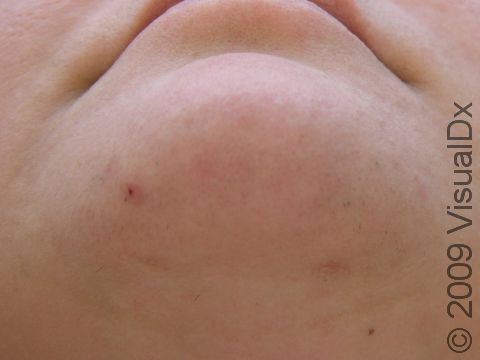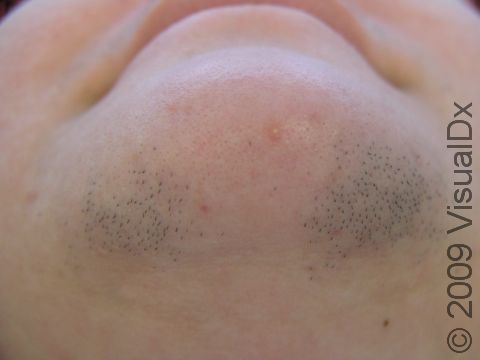Hair Removal, Laser
Laser or intense pulsed light (IPL) technology can be used to superheat and permanently remove hair. The light targets the pigment in the hair, and the ideal candidate for laser hair removal is a person with lighter skin and dark, coarse hair. With the latest technology, all skin types can be treated, although more treatments may be required for people with darker skin colors. Removing hair that is white, gray, blond, red, or that is fine is more challenging.
Usually 2-6 laser hair removal treatments are needed to adequately remove the unwanted hair, and the hair should not regrow for several months to years. Hair that regrows is typically finer and lighter than the original hair.
What to Expect During Your Visit
Preparation for the treatment includes:
- Avoiding tanning at least 2 weeks prior to laser hair removal.
- Wearing sunblock and sun-protective clothing for the same period of time.
- Avoiding removing hair at the root for 1 month before treatment (meaning you should not pluck, wax, or thread the hair).
It is fine to shave, bleach, trim, or use a depilatory for hair removal prior to laser hair removal.
The medical professional may recommend using a topical anesthetic cream for 30-90 minutes before treatment to numb the area. The skin is then cleaned, and the hairs in the area to be treated are shaven. You will be directed to put on eye protection, which the medical professional will also wear. The medical professional will then take the laser handpiece and place it over the area to be treated, and a pulse of light is emitted. Each pulse is approximately the size of a coin. Laser treatment is usually fairly quick for a small area such as the upper lip, potentially taking only a few minutes, but it may take an hour or more for large areas, such as the legs. When no numbing cream is used, some people compare the pain of the laser treatment to a superheated needle briefly entering the skin.
What to Expect After Your Visit
Immediately following laser hair removal, your skin may be red or darker than the surrounding skin, and it may be swollen around the hair follicles, but this is generally mild and should only last 1-3 days.
Following your first laser hair removal treatment, you can expect a noticeable reduction in hair in the treated area, usually a 10%-25% reduction.
Follow-Up Care
If you experience a burning sensation or swelling following laser hair removal, applying a cool compress can help ease your discomfort.
Gentle skin care and sun protection are both important to promote proper healing following laser hair removal, especially in the 2 weeks following laser hair removal. Gentle skin care involves avoiding potentially irritating skin products (eg, those containing glycolic acid, alcohol) as well as excessive scrubbing or rubbing. Using a moisturizing broad-spectrum sunblock (one that protects against both UVA and UBV rays) of SPF 30 or higher following the procedure serves a dual role of preventing sun-induced darkening of the skin and soothing irritated skin after laser hair removal.
Risks and Potential Side Effects
Risks associated with laser hair removal include:
- Lack of results.
- Blistering.
- Skin that is darker or lighter than surrounding skin, either temporarily or sometimes permanently.
- Scarring.
- Stimulation of new hair growth (extremely rare).
These risks are greatly reduced when laser hair removal is done by a medical professional with experience using lasers and one who has excellent knowledge of the skin, ideally a board-certified dermatologist.
When to Seek Medical Care
See your medical professional for any follow-up care or additional treatments.
Contact your medical professional if you have signs of infection (such as pain, spreading redness, or fever) following laser hair removal.
References
American Academy of Dermatology Association. Laser hair removal: FAQs. AAD. https://www.aad.org/public/cosmetic/hair-removal/laser-hair-removal-faqs. Accessed 2024 May 8.
Jagdeo J, Shive M, Hruza G. Laser- and light-based approaches to hair removal. In: Kantor J. Dermatologic Surgery. McGraw-Hill Education; 2018.
Orringer JS. Nonablative laser and light-based therapy: cosmetic and medical indications. In: Kang S, Amagai M, Bruckner AL, Enk AH, Margolis DJ, McMichael AJ, Orringer JS, eds. Fitzpatrick’s Dermatology. 9th ed. New York, NY: McGraw-Hill Education; 2019.
Last modified on May 14th, 2024 at 12:16 pm

Not sure what to look for?
Try our new Rash and Skin Condition Finder

